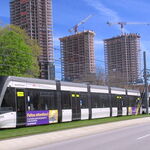I've just erased a number of prior quotes as to using the Lakeshore route revisited. Urban Sky has addressed them, as has this forum prior. There's massive challenges *financially* as well as the land even being available, let alone the bridges of size needed to cross various rivers.
Reopening an old rail corridor that's in disuse will surely trigger an EA as well.
The Transportation Act and others say otherwise. Been quoted many times here, I'll find it again and link, but basically, IIRC (gist) "Up to 100 metres either side of the centre of the present RoW does not require EA or approval, merely the application to the (Minister and/or Regulator)"
D-S articulates this in detail, as do the Acts pertinent, even some publications of the Acts providing an application form to be filled out to the (regulator).
There's a damn good reason the P'bro route was chosen, not least because it's overall the best all things considered. VIA Has made clear that Kingston *isn't* to be 'sidelined' and the Mayor of Kingston and the surrounding counties are all on-side with this.
Railway line Includes a main line, branch line, yard tracks, sidings, spurs or other track auxiliary.
Agency approval is
not required to construct a railway line if:
- The proposed railway line is within the right of way of an existing railway line;
- The proposed railway line is within 100 metres of the centre line of an existing railway line for a distance of no more than 3 kilometers; or,
- A port authority, incorporated under the Canada Marine Act, constructs a railway line on lands that it manages, holds or occupies.
There's more as per 'reactivating an abandoned RoW' not needing approval (certain conditions pertain, voluntary, to consider the local planning protocols where possible) also quoted directly from the Act (Transpo or Crossings and Relocations Act, both difficult to research now they've made them 'new an improved')
It's actually easier at this point to Google what's already been posted in this string than the Acts in full on-line. I'll link and reference later.
And btw: The working figure for electrifying a railway line in the US is '$100M per mile'. I read extensively on that last night, didn't bother keeping references, it's such an accepted working figure. It's what's being used now for both east and west coast electrification projects, and CalTrains, the complication with the latter that costs are radically slashed due to combing it with the Cal High Speed project *( see note at end) and Fed subsidies for doing it. For multitrack, the cost per distance is a fraction for the added tracks beyond for just one. Anyone doubling the 'working cost' for a single track where doubled is obviously not availed of the facts. In fact, there's a clever way of using the '25kV X 2' (50kV centre-tapped via autotransformer method) that saves a massive amount when doing doubled track, and increases regenerative yield efficiency doing it . I'm a tech at one time specializing in transformer development. Anyone care to challenge me on it?
If someone wants to take that to issue, then I digress. State your reference.
* Note: High Speed requires a much more robust catenary, in all respects, including current capacity as well as physical strength, and the cost per distance to calculate overall distance is considerably higher than what HFR (or CalTrains) requires. In this respect, CalTrains gets deluxe corridor access catenary for a fraction of what it would normally cost. Politics has complicated this in the present manifestation of Cal High Speed though.
For those not familiar with D-S' stated views on HFR (including reusing old trackbeds and underutilized freight lines) here it is in testimony to Parliament:
STANDING COMMITTEE ON PUBLIC ACCOUNTS
NUMBER 021
l
1st SESSION
l
42nd PARLIAMENT
EVIDENCE
THURSDAY, JUNE 16, 2016
[...]
Mr. Yves Desjardins-Siciliano:
What we are proposing to do, which is somewhat cheap and quite fast to deploy, is acquire existing freight railway beds and repurpose them for passenger rail. They are currently abandoned or of very little use, so we would operate them. For the freight traffic that runs on those tracks, which is usually a train a day or two trains a week, we would control when they run. Obviously we would make them run when we are not running passenger trains.
[...]
http://www.ourcommons.ca/DocumentViewer/en/42-1/PACP/meeting-21/evidence



